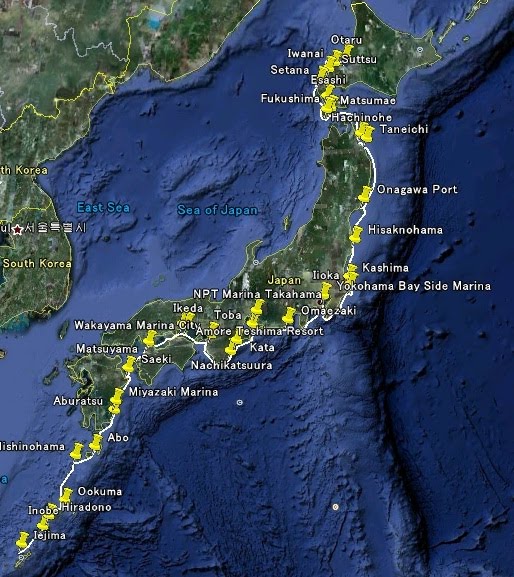08:00 Taneichi port for Fuel 282L
11:40 Cape Todogasaki
12:40 Passed Kamaishi Harbor
14:30 Passed Kesennuma Harbor
17:00 Arrived to Onagawa Port, fuel 330L
We departed at 05:00 from Hachinohe harbor. We couldn't get fuel in such an early morning. We had to find a appropriate port to get fuel.
It was beautiful tranquil morning with fog. On the gate island of Hachinohe harbor, there is a small shrine. Many Japanese believe that we connect with forefathers and they are living with us in the shrine. We prey for them when we go to the deadly work, and thank when we return to home. Fishing is one of the deadliest work. Many fishermen pray for the shrine wishing safety cruise.
It was foggy day, but we had 5 miles view on the sea. It was not big problem.
At 8:00, we entered in the Taneichi marine. But this marina was closed in spring season. So we got out from Taneichi Marina and entered into the fishing port. Several fisherman gathered to buy the fishes were very interested in our Minor29DC. The Minor29DC is a cute boat, and looks like fishing boat. I read an article describing her that a Minor29's original design was fishing boat. I guess fisherman are familiar with her shape.
"I think she is a good one." one fisherman said.
"I think some young man in this village buy it."
"What is the maximum speed?"
"What is the average speed of it?"
"How much is the fuel comsumption?"
bra,bra,bra... We enjoyed the conversation with them.
They amused that we come from the Otaru port and we would go to Yokohama.
In Japan there are many conflict between pleasure boats and fishing boats. But the Minor29DC was welcomed at any fishing port.
After refuel our boat, we departed the Taneichi port. We passed Cape Todogasaki at 11:40. Todogasaki means there were lots of sea lions on the cape. Indeed, we met sea lions more than ships.
"I think she is a good one." one fisherman said.
"I think some young man in this village buy it."
"What is the maximum speed?"
"What is the average speed of it?"
"How much is the fuel comsumption?"
bra,bra,bra... We enjoyed the conversation with them.
They amused that we come from the Otaru port and we would go to Yokohama.
In Japan there are many conflict between pleasure boats and fishing boats. But the Minor29DC was welcomed at any fishing port.
After refuel our boat, we departed the Taneichi port. We passed Cape Todogasaki at 11:40. Todogasaki means there were lots of sea lions on the cape. Indeed, we met sea lions more than ships.
Kamaishi bay at 12:40.
That is a natural harbor since ancient times. The depth of the Kamaishi quay is 63 meters. That is the deepest quay in the world. The Guinness approved it and recorded it in the book.
That is a natural harbor since ancient times. The depth of the Kamaishi quay is 63 meters. That is the deepest quay in the world. The Guinness approved it and recorded it in the book.
The temperature around here was upper 15 degrees celsius. It was warmer than Hokkaido very much. I could sit down on the stern deck. The Minor29DC could go linearly at 17 knots speed like a train on the rails.
In the afternoon, it was rainy, we couldn't keep high speed. After the time 17:00, I began to think it was better to get entering to the port, we entered into the Onagawa Port. We took the inn Yamadai next to the port.
Yamadai Inn. This inn was a typical inn near the port.
We had delicious sea-urchin dinner.
Sea-urchin alived every where in the sea around Onagawa port.
Fuel was 330L
Yamadai Inn. This inn was a typical inn near the port.
We had delicious sea-urchin dinner.
Sea-urchin alived every where in the sea around Onagawa port.
Fuel was 330L
















































